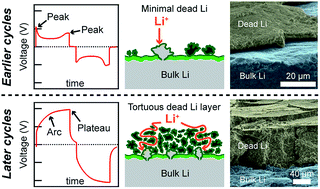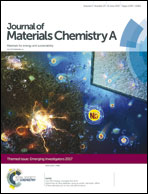Dead lithium: mass transport effects on voltage, capacity, and failure of lithium metal anodes†
Abstract
Improvement of the performance of Li metal anodes is critical to enable high energy density rechargeable battery systems beyond Li-ion. However, a complete mechanistic understanding of electrode overpotential variations that occur during extended cycling of Li metal is lacking. Herein, we demonstrate that when using a Li metal electrode, the dynamic changes in voltage during extended cycles can be increasingly attributed to mass transport. It is shown that these mass transport effects arise as a result of dead Li accumulation at the Li metal electrode, which introduces a tortuous pathway for Li-ion transport. In Li–Li symmetric cells, mass transport effects cause the shape of the galvanostatic voltage response to change from “peaking” to “arcing”, along with an increase in total electrode overpotential. The continued accumulation of dead Li is also conclusively shown to directly cause capacity fade and rapid “failure” of Li–LCO full cells containing Li metal anodes. This work provides detailed insights into the coupled relationships between cycling, interphase morphology, mass transport and the overall cell performance. Furthermore, this work helps underscore the potential of Li–Li symmetric cells as a powerful analytical tool for understanding the effects of Li metal electrodes in full cell batteries.

- This article is part of the themed collections: 10th Anniversary: Most popular articles, 2017 Journal of Materials Chemistry A HOT Papers and Journal of Materials Chemistry A Emerging Investigators


 Please wait while we load your content...
Please wait while we load your content...